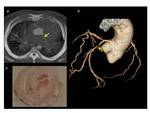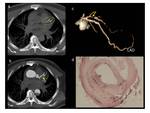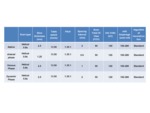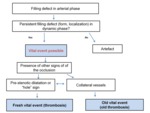Purpose
Any sudden,
unexpected death is a reason for medico-legal investigation.
The underlying cause of sudden death is frequently cardiovascular with ischemic heart disease being most common.
In recent years,
postmortem MDCT (PMCT) and postmortem CT-angiography (PMCTA) have been used in the investigations of cardiovascular pathologies.
The goal of this presentation is to explain the current approach for postmortem radiological investigation of atherosclerotic coronary artery disease.
Methods and Materials
Since 2009,
our center has investigated forensic cases by a standardized technique of PMCTA,
called multi-phase PMCTA (MPMCTA).
One of the main indications for this examination is suspicion of coronary artery pathology.
Radiological investigations
An unenhanced CT scan and subsequent y MPMCTA are performed before the classical autopsies following the standard protocol of MPMCTA (Fig 1).
A native CT-scan is performed prior to any manipulation of the body with an 8-row CT-unit (CT LightSpeed 8,
GE Healthcare,
Milwaukee,
WI,
USA).
Post-mortem liquid samples for toxicological...
Results
More than 500 post-mortem cases were analysed with PMCT of MPMCTA in our centre.
PMCT reveals the presence of coronary artery calcification.
MPMCTA additionally allows for the evaluation and documentation of coronary artery lumina,
and the detection of myocardial lesions such as myocardial rupture,
and in some cases,
myocardial infarction.
The most essential component of MPMCTA in the evaluation of the coronary arteries is to compare the different phases of angiography,
specifically the arterial and dynamic phase.
Any stenosis or occlusion of a coronary artery,...
Conclusion
Post-mortem coronary CT-angiography is a relatively new field in radiology,
and more comprehensive and larger studies are needed to encourage the use and the evaluation of this technique.
After having investigated more than 500 cases of MPMCTA,
it was possible to propose a key for radiological reading of coronary artery pathology.
This key needs to be evaluated in other centers and adapted,
according to the results of further studies.
We believe that the knowledge obtained in PMCTA could also improve the understanding of radiological presentations...
References
Grabherr S,
Djonov V,
Yen K,
Thali MJ,
Dirnhofer R.
Postmortem angiography: review of former and current methods.
AJR American journal of roentgenology.
2007;188(3):832-8.
Grabherr S,
Doenz F,
Steger B,
Dirnhofer R,
Dominguez A,
Sollberger B,
et al.
Multi-phase post-mortem CT angiography: development of a standardized protocol.
International Journal of Legal Medicine.
2010:1-12.
Roberts ISD,
Benamore RE,
Peebles C,
Roobottom C,
Traill ZC.
Diagnosis of coronary artery disease using minimally invasive autopsy: evaluation of a novel method of post-mortem coronary CT angiography.
Clinical Radiology.
2011;66(7):645-50....





